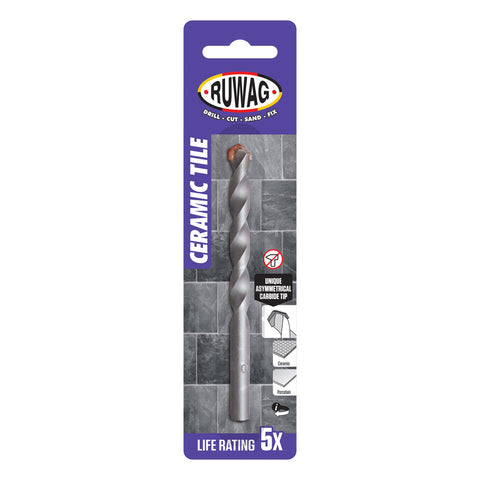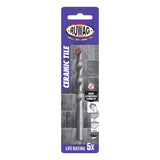Description
The Ceramic Tile drill bit is used for drilling into ceramic and porcelain tiles.
- Long life asymmetrical carbide tip
- Not for use with Hammer Action
- For use in up to class 4 tiles
Tile/Glass drill bit selection chart
Slide to view full table.
|
Ceramic & porcelain tiles PEI rating |
||||||||
| Glass | Class 0 | Class 1 | Class 2 | Class 3 | Class 4 | Class 5 | Granite | |
|---|---|---|---|---|---|---|---|---|
| Glass & Tile bit | ✔ | ✔ | ✔ | ✔ | ✔ | |||
| Ceramic Tile bit | ✔ | ✔ | ✔ | ✔ | ✔ | ✔ | ||
| Diamond core bit | ✔ | ✔ | ✔ | ✔ | ✔ | ✔ | ✔ | ✔ |
Tile Ratings
Class 0: Unsuitable for floors. These are generally used as wall tile.
Class 1: Suitable only for locations where softer footwear is worn or where shoes are not frequently used, for e.g. residential bathroom or other areas with light traffic. Also for interior commercial and residential walls.
Class 2: Suited for general residential traffic; for areas that are walked on by soft soled or "normal" footwear with very small amounts of scratching dirt. Not for kitchen, entrance halls, stairs and other areas subjected to heavy traffic.
Class 3: Suited for all residential and light commercial areas such as offices, reception areas, boutiques, interior walls, countertops and residential bathroom floors. Not recommended for commercial entryway.
Class 4: Suited for regular traffic. Recommended for medium commercial and light institutional use, such as restaurants, hotels, hospital lobbies and corridors.
Class 5: Suitable for areas with heavy traffic, abrasive dirt and moisture, and where safety and maximum performance are required. Examples are shopping centres, public buildings, building entrances or swimming pools.
QUESTIONS & ANSWERS
Ask a Question-
What is the ideal speed for this drill bit? Is it preferable to run wet?
Low speed is recommended for these bits, lower than 400RPM.
Cooling the bit by dipping it in water occasionaly will increase it's lifespan.



